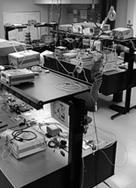|

Andrew G. Kirk
|
Interaction of light
with periodic micro- and nanostructures: Analysis, integration and
application
My research is concerned with the interaction between light and artificially
structured materials and finds application in both telecommunications and
biosensing. The recognition that light will be diffracted by small-scale
structures goes back hundreds of years, but applications and new
understandings continue to emerge today. At present we are focusing on the
following research topics:
1. Slab waveguide optical demultiplexers and
switches: We are investigating a variety of devices in slab waveguides,
in which light is confined in the vertical direction but can propagate freely
in the other two dimensions. It can thus be thought of as ‘flat’ free-space
optics, into which we are integrating many different structures. These can
combine the characteristics of both free-space and guided wave devices.
Examples include photonic crystal superprism demultiplexers, distributed etched grating demultiplexers and electro-optic switches, fabricated in
silicon-on-insulator and GaAs. These devices are intended for next-generation
agile all-optical networks.
2. Vertical integration strategies for photonic systems: We are
investigating techniques to stack different optical materials and devices
vertically, in order to integrate different materials and devices together
more effectively. The key challenge here is to develop compact vertical
interconnects (the equivalent of vias in
microelectronics) that are also efficient. The eventual goal is to integrate
active devices (lasers, amplifiers and detectors) with passive optical
waveguides, with application in chip-to-chip interconnects.
3. Surface plasmon resonance biosensors: Surface plasmon resonance
(SPR) is a widely used affinity biosensing technique. We are attempting to
increase the sensitivity of SPR sensors, both through the use of metallic
optical nanostructures and also by spatially selective surface chemistry. We
are working closely with researchers in medical departments in order to
target the detection of particular biomarkers.
|






